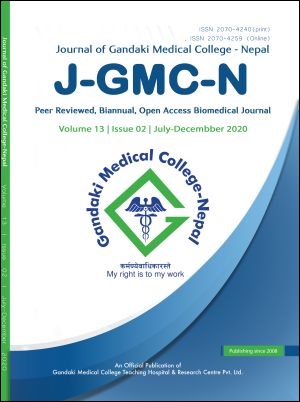Sex- related morphometric difference in sternal index and dimensions amongst Nepalese adults
DOI:
https://doi.org/10.3126/jgmcn.v13i2.30729Keywords:
manubrium, mesosternum, overlapping zone, sternal indexAbstract
Introduction: The comprehensive goal in forensic anthropology is the identification of skeletal remains for which researchers are constantly working to produce methods that are as accurate as possible. Because of distinct sexual dimorphism, bones of the pelvis and skull are preferred; however, when these bones are unavailable other bones like sternum have to be used as it holds a great deal of sexual dimorphism.
Objective: To evaluate sexual dimorphism in the metric parameters of the sternum through MDCT images amongst Nepalese adults.
Materials and Methods: Sternal dimensions of 105 study participants (62 male and 43 female) were measured using Computed Tomography (CT) images from Radiology Department of Dhulikhel Hospital. An independent t test was performed to assess the strength of association between different variables and genders. Differences were considered significant at P < 0.05. ROC curve analysis was done to determine the discriminating power of variables for sex determination.
Result: The different measurements of sternal lengths were significantly greater in male than females(p<0.001) except Sternal Index which was found to be higher in female (p<0.001). Despite this difference in mean, most of the sterna were in overlapping zone. The limiting point of 126 was determined for total sternum which could correctly classify majority of sternum. Using ROC curve the mesosternum and total sternum were found to be most accurate (>95%) in sex determination. Hyrtl’s law could classify 91.9% of the male and Ashley’s rule of 136 could 97.67% of the female.
Conclusion: Hence this study made an effort in sexing the sternum in Nepalese population amongst which mesosternal length and total sterna length were found to be best estimators of sex whereas manubrium length and sternal index were not found to be satisfactory.
Downloads
Downloads
Published
How to Cite
Issue
Section
License
This license allows reusers to distribute, remix, adapt, and build upon the material in any medium or format for noncommercial purposes only, and only so long as attribution is given to the creator.




